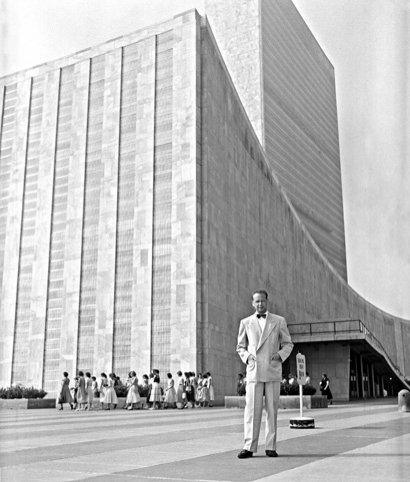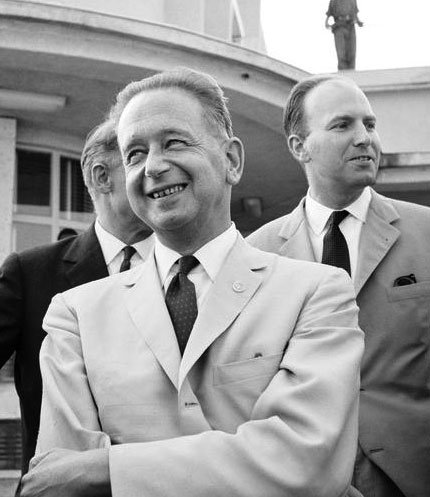The Light of Commitment:Revealing the Inner Faces of Hammarskjöld
In Dag Hammarskjöld and the 21st Century, a 2001 lecture delivered in Sweden, presiding Secretary-General Kofi Annan found ample words adequate for a tribute to his predecessor: "His life and death, his words and his actions, have done more to shape public expectations of the office, and indeed of the Organization, than those of any other man or woman in its history. His wisdom and his modesty, his unimpeachable integrity and single-minded devotion to duty, have set a standard for all servants of the international community… which is simply impossible to live up to. There can be no better rule of thumb for a Secretary-General, as he approaches each new challenge or crisis, than to ask himself, 'how would Hammarskjöld have handled this?'... What is clear is that his core ideas remain highly relevant in this new international context. The challenge for us is to see how they can be adapted..."
At our recent Book Talk event, held partly in observance of the 60th anniversary of Dag Hammarskjöld's inauguration as second Secretary-General of the United Nations, Signe Burgstaller, Deputy Permanent Representative of Sweden to the UN, also attempted to highlight some of the significant attributes of her distinguished fellow countryman.
"It turned out that Hammarskjöld was much more than an efficient administrator of the UN Secretariat. He came with a very clear vision for the UN, constantly striving for it to be a dynamic instrument in the hands of its member states… His efforts to assert the independence, integrity and dignity of the organization indeed bore fruit, and his work in preventative diplomacy blazed a trail for the Secretary-General's direct diplomatic engagement as a mediator. His multi-lateral diplomatic skills and personal qualities set an example for all international civil servants to this day...
"As many others have testified, his legacy remains most relevant to the UN and its member states today," she continued. "Understanding the life, mind and service of Hammarskjöld is to also understand something about the evolution of the UN itself. A great contribution in this regard is the new biography of the man by Dr. Lipsey."
To our delight, it was an evening of special insight as Roger Lipsey — a rare gentleman scholar, art historian, editor and translator who was our guest for this Book Talk — revealed many facets of Hammarskjöld's mind and character. Drawing on previously unpublished sources and correspondence, and directing our attention to the more substantial within all of the surfaces and details of Hammarskjöld's life, Lipsey has created in his book Hammarskjöld: A Life a work of great scope and penetrating access, and one which can stand beside Brian Urquhart's equally monumental 1972 work on the subject. While the latter's lastingly important status remains without question in its depth of portraiture and event, the more subtle and profound intricacies of the subject — wherein the conjunction of inner life and outer reality evoke mirrored effects and alchemy — emerge in the rather pronounced difference of Dr. Lipsey's sophisticated account of Hammarskjöld's spiritual journey.
"Our topic tonight — one of UN diplomacy, with the purpose of re-establishing peace with justice — is to speak of that in Hammarskjöld's terms as a profound cultural and creative act. That was how he lived it, and how he taught it," Dr. Lipsey began, while choosing a slideshow as a rather special way to engage our sensibilities, by summoning images of Hammarskjöld from his life — his places and abodes, his moments of encounter, his body language, his writings — as well as something more intriguingly elusive, which nonetheless could be discerned as he selectively guided our regard through the monochrome photographs.
Following is a small selection of some of these highlights:
"This is a portrait from his middle years at the UN, which we can take as quite classic… This is the marvelously blue-eyed, marvelously composed, curiously warm, curiously cold and remote Mr. Hammarskjöld…"
"I wanted to show you his office, it captures the loneliness of the man… On the one hand, the position of Secretary-General involves a myriad of relationships, and a certain distance of necessity… and that distance, that solitude, of someone who cannot be compromised, who must enter in but must not be swallowed up… is somehow reflected in this image… He eventually understood that his aloneness, which is different from loneliness, had to be — that it was a personal structure, an identity, that he could not overcome — and need not."
"One of my favorite photos: it shows a clever man, a shrewd man… it is a highly intelligent face… in that raised eyebrow and wrinkled brow is an entire look of someone who has been around the block."
"The event that both thoroughly tested him, and also created his reputation among the delegations to the UN, was the mission to Peking (now Beijing) in 1955."
Hammarskjöld attempted to secure the release of American prisoners of war captured during the Korean War, by flying to China (then without a seat at the UN), and tried to meet with Premier Zhou Enlai. People around him strongly advised against the visit. Yet without official entourage or his own interpreter, Hammarskjöld was able to state the following during one of their private sessions:
"It does not mean that I appeal to you or that I ask you for their release. It means that — inspired also by my faith in your wisdom and in your wish to promote peace — I have considered it my duty as forcefully as I can, and with deep conviction, to draw attention to the vital importance of their fate to the cause of peace… Their fate may well decide the direction in which we will all be moving in the near future — towards peace, or away from peace… Against all odds, [this case] has brought me around the world in order to put before you, in great frankness and trusting that we see eye to eye on the desperate need to avoid adding to existing frictions, my deep concern both as Secretary-General and as a man."
Extended negotiations over 10 months were finally successful, clearly demonstrating his patience and seriousness of purpose to the world. The success in China of his "splendid and harrowing" encounter with Zhou also depended on a newly expanded sense of duty which demanded him to pass through, as Lipsey writes in his book, a "heightened challenge and awareness in which his ordinary experience of "I" yielded to another identity…" These negotiations were far from the safety of solitude, and perhaps well illuminated by an excerpt from Hammarskjöld's private journal: "At high altitudes, a moment's self-indulgence may mean death."
There were two sides to Hammarskjöld: one was the diplomatic genius of his time, the other was the solitary journal keeper, an activity revealed only after his death. When a close friend into whose hands the journals were entrusted decided on their publication, generations of readers entered into the intimacy of the volume entitled Markings, to which both the poet W. H. Auden and Jimmy Carter contributed forewords.
Although he had early rejected his family's Lutheran faith, his search for spiritual meaning continued throughout his life, and led him to read the writings of Christian mystics like Meister Eckhart and Thomas à Kempis, as well as finding additional nourishment and spiritual access in eastern traditions such as Buddhism and Taoism. Hammarskjöld's journal provides many glimpses into the actualities of his experiences, and reveal something of the intersection at which he found himself, where the spiritual conjunction with the mundane compelled him to perform many profound transitions beyond personal limitation. Much of the meaning of his life emerges from this sense of living on the threshold of experience, which can often threaten to demand everything, and yet effectively produce great achievements.
Until his death in a plane crash while en route to negotiate a ceasefire in the Congo Crisis in 1961, Hammarskjöld also made efforts to improve ties between Israel and its Arab neighbors, as well as helped to diffuse the Suez Crisis. His use of UN forces in the Congo to keep the peace in the newly-independent nation against secessionist armies earned a reproach from the Soviet Union, which demanded his removal from office. The plane crash was officially ruled an accident, but questions remain about the circumstances of his death — which has been the focus of a special investigation that promises to announce new findings later this year.
We are grateful for Roger Lipsey for sharing so generously from his illuminating considerations of Hammarskjöld's life and his meaning for us today. We hope you will also enjoy a further sample of his gracious yet penetrating sensibility, by watching his participation recently at the UN, commemorating the 60th Anniversary of Dag Hammarskjöld's Inauguration (view the webcast). There are also appearances by UN Secretary-General Ban Ki-moon, Sir Brian Urquhart and UN Deputy Secretary-General Jan Eliasson, who cited Hammarskjöld's quotation in his acceptance speech of lines by a Swedish poet: "The greatest prayer of man does not ask for victory, but for peace."
Hammarskjöld posthumously received the Nobel Peace Prize in 1961.
A fitting coda can be found in the rueful eulogy by U.S. president John F. Kennedy, in which he regretted his opposition to the UN policy in the Congo: "I realise now that in comparison to him, I am a small man. He was the greatest statesman of our century."
SELECT LINKS
UN WEBCAST | 10 April 2013 | Commemorating 60th Anniversary of Dag Hammarskjöld's Inauguration as Secretary-General | with appearances by Ban Ki-moon, Sir Brian Urquhart and Professor Lipsey
dag-hammarskjold.com
A unique online resource created by Dr. Lipsey, exploring Hammarskjöld's political wisdom
Dag Hammarskjöld Foundation
Dedicated to carrying out Hammarskjöld's vision








